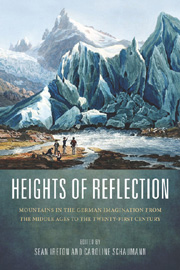 Heights of Reflection
Heights of Reflection Book contents
- Frontmatter
- Contents
- Acknowledgments
- Introduction: The Meaning of Mountains: Geology, History, Culture
- Prelude: Classical Mountain Landscapes and the Language of Ascent
- Part I First Forays: Mountain Exploration and Celebration from the Middle Ages to the Eighteenth Century
- Terra Incognita? Mountains in Medieval and Early Modern German Literature
- From Meadows to Mountaintops: Albrecht von Haller's “Die Alpen”
- Interlude: Geo-Poetics: The Alpine Sublime in Art and Literature, 1779–1860
- Time and Narrative in the Mountain Sublime around 1800
- Faust's Mountains: An Ecocritical Reading of Goethe's Tragedy and Science
- Spectacular Scenery and Slippery Descents: Narrating the Mountains of Tropical Polynesia
- Part II Beckoning Heights: Summits Near and Far in the Nineteenth Century
- Part III Modern Expeditions and Evocations: Climbing from the Twentieth into the Twenty-First Century
- Works Cited
- Notes on the Contributors
- Index
Spectacular Scenery and Slippery Descents: Narrating the Mountains of Tropical Polynesia
from Part I - First Forays: Mountain Exploration and Celebration from the Middle Ages to the Eighteenth Century
Published online by Cambridge University Press: 05 February 2013
- Frontmatter
- Contents
- Acknowledgments
- Introduction: The Meaning of Mountains: Geology, History, Culture
- Prelude: Classical Mountain Landscapes and the Language of Ascent
- Part I First Forays: Mountain Exploration and Celebration from the Middle Ages to the Eighteenth Century
- Terra Incognita? Mountains in Medieval and Early Modern German Literature
- From Meadows to Mountaintops: Albrecht von Haller's “Die Alpen”
- Interlude: Geo-Poetics: The Alpine Sublime in Art and Literature, 1779–1860
- Time and Narrative in the Mountain Sublime around 1800
- Faust's Mountains: An Ecocritical Reading of Goethe's Tragedy and Science
- Spectacular Scenery and Slippery Descents: Narrating the Mountains of Tropical Polynesia
- Part II Beckoning Heights: Summits Near and Far in the Nineteenth Century
- Part III Modern Expeditions and Evocations: Climbing from the Twentieth into the Twenty-First Century
- Works Cited
- Notes on the Contributors
- Index
Summary
Compared to the heroic tales of mountaineering in the Alps, the Himalayas, or the Andes, the narratives about climbing volcanoes in the Pacific do not even come close in drama. Most tourists today fly to Hawaii and other tropical islands to lie on the beach, surf the waves, snorkel in the pristine waters, enjoy the sunshine, and smell the tropical flowers, but not to exert themselves on strenuous hikes. The Pacific is, after all, “a place of dreams,” as Rod Edmond recently reminded us. Travel guides caution even the physically fit visitor about summiting peaks in the Pacific during the heat of the day. Climbers posting online at summitpost.org, for example, characterize Tahitian mountains as wet and rainy. One climber “came to the more accurate conclusion that small things can also come in terrifying packages.… Holding on to a rope while descending wet rock covered with slick mud having the consistency of glazed snot, while dangling over a 370 meter/1,200 foot void in the rain does not inspire confidence.” Mt. Orohena, the highest peak in Tahiti, rises an impressive 2,241 m/7,352 ft. above sea level and is a challenging climb by any measure. In their trip reports, climbers seem to distinguish between the stunning views from the summits of Tahitian mountains and the actual ascent and descent. It is this bifurcation that characterizes mountaineering discourses in tropical Polynesia, a trope that was first articulated by German explorer and scientist George Forster in the latter half of the eighteenth century.
- Type
- Chapter
- Information
- Heights of ReflectionMountains in the German Imagination from the Middle Ages to the Twenty-First Century, pp. 134 - 150Publisher: Boydell & BrewerPrint publication year: 2012


